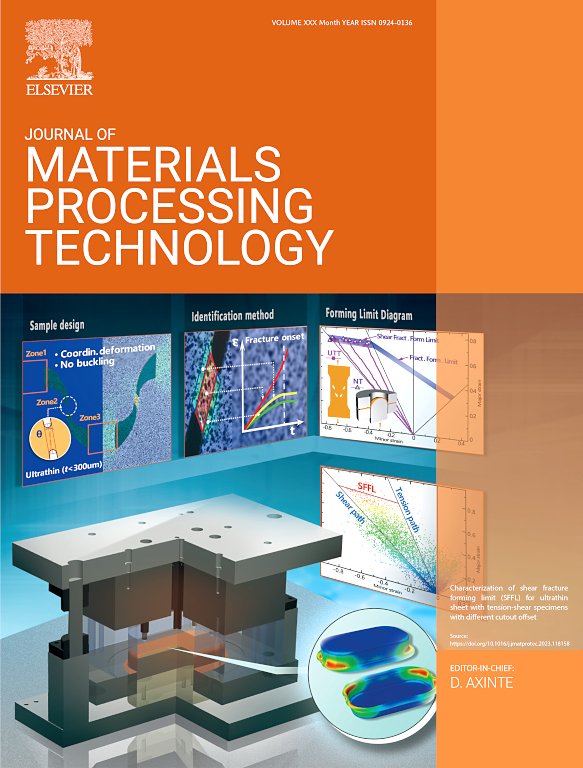通过等离子精加工和琢磨实现低损伤光学制造
IF 6.7
2区 材料科学
Q1 ENGINEERING, INDUSTRIAL
Journal of Materials Processing Technology
Pub Date : 2024-10-11
DOI:10.1016/j.jmatprotec.2024.118633
引用次数: 0
摘要
精密光学元件对表面粗糙度、形状误差和次表面损伤有着严格的要求,以获得卓越的性能。然而,由于使用了磨料,熔融石英的传统研磨、研磨和抛光工艺不可避免地会产生表面下损伤(SSD)。因此,本文提出了一种无磨料、低损伤的熔融石英光学元件制造工艺,该工艺结合了电感耦合等离子体 (ICP) 的固态表面损伤恢复和电容耦合等离子体 (CCP) 的形状误差校正。本文主要旨在揭示组合等离子工艺的优势和挑战。首先验证了 ICP 精加工的 SSD 恢复能力。通过对比缓冲氧化物蚀刻(BOE)和电容式等离子体蚀刻后的表面形貌,发现大面积的表面粗糙是由等离子体蚀刻而非 SSD 引起的。对 ICP 和 CCP 组合的实验研究表明,ICP 光饰不仅能恢复 SSD,还能抑制等离子蚀刻造成的表面粗糙。对 ICP 精加工后形状误差的研究表明,诱发的形状误差包括工件变形和具有凹坑状结构的局部变形,影响了 CCP 图解的精度和持续时间。通过联合等离子工艺,获得了粗糙度小于 Sa 0.3 nm、形状误差小于 RMS 20 nm 的低损伤表面。本文章由计算机程序翻译,如有差异,请以英文原文为准。
Low-damage optical manufacturing via plasma finishing and figuring
Precision optical components have stringent requirements on surface roughness, form error, and subsurface damage for superior performance. However, conventional grinding, lapping, and polishing processes of fused silica inevitably introduce subsurface damage (SSD) due to the use of abrasives. Thus, this paper proposes an abrasive-free, low-damage manufacturing process for fused silica optical components, which combines inductively coupled plasma (ICP) for SSD recovery and capacitively coupled plasma (CCP) for form error correction. This paper mainly aims to reveal the advantages and challenges of the combined plasma process. The SSD recovery capability of ICP finishing was first verified. The comparison of surface morphology after buffered oxide etch (BOE) etching and CCP etching revealed that extensive surface roughening is caused by plasma etching rather than SSD. Experimental studies on the combination of ICP and CCP demonstrated that ICP finishing can not only recover SSD but also inhibit the surface roughening by plasma etching. The investigation of form error after ICP finishing revealed that the induced form error consists of workpiece distortion and localized deformation with a crater-like structure, affecting the precision and duration of CCP figuring. The combined plasma process was conducted and a low-damage surface with roughness less than Sa 0.3 nm and form error less than RMS 20 nm was achieved.
求助全文
通过发布文献求助,成功后即可免费获取论文全文。
去求助
来源期刊

Journal of Materials Processing Technology
工程技术-材料科学:综合
CiteScore
12.60
自引率
4.80%
发文量
403
审稿时长
29 days
期刊介绍:
The Journal of Materials Processing Technology covers the processing techniques used in manufacturing components from metals and other materials. The journal aims to publish full research papers of original, significant and rigorous work and so to contribute to increased production efficiency and improved component performance.
Areas of interest to the journal include:
• Casting, forming and machining
• Additive processing and joining technologies
• The evolution of material properties under the specific conditions met in manufacturing processes
• Surface engineering when it relates specifically to a manufacturing process
• Design and behavior of equipment and tools.
 求助内容:
求助内容: 应助结果提醒方式:
应助结果提醒方式:


